Interview with organic homesteaders in Mexico; Edited by Zoe Wilcox-Edrington for clarity

Despite the location in the world, the ethics that make sustainability possible remain the same. As gardeners and landscapers, my husband and I have spent many winters hugging the wood stove and our winter savings, resulting in boredom and the blues. So this winter, we planned ahead and took our winter savings to spend a month on the Pacific coast of central Mexico. We set our destination for Slow Living Farms, a 10-acre self-sustaining farm over looking the ocean. Wally Carlson and Amaranth Rose sustain themselves there off their organic mango crop and the eco-tourists who relax in their artistically designed guesthouse on the property. To make our stay affordable, our family (one and a half year old in tow) stayed as WWOOFers (Willing Workers on Organic Farms) and worked for our room and board.
Wally Carlson, a gentle and introverted soul, started nurturing this farm eighteen years ago when he bought the land, then exhausted by the previous farmer and considered wasteland. Wally drove his VW van (what we called home while we were there) to the property, parked, and never left except for mandatory visits to the States. He began planting fruit trees, native and cultured varieties of which 30-40 now thrive, and began assimilating himself into the local community, a small and intimate fishing village. Life remained rough on the farm: van living, cold bucket showers, and meals at the taco stand in town, until five years ago when he met the deeply spiritual, Amaranth Rose. A lifetime gardener and artist, she filled the missing link in creating a successful and comfortable sustainable farm. The peace the two experience with each other and the Earth beneath them while walking the walk of sustainability inspired me to interview them. I wanted to better understand the mindset that got them to the beautiful and harmonious lifestyle they now enjoy. Although they live in the tropics, I was sure they had wisdom to help me attain sustainability in the high desert. I interviewed them separately, to clearly understand the experience and ideas of both.
Interview with Wally Carlson:
How did you make your living before moving here?
Wally: Before moving here, I was a mechanic for cars and tractors. I worked on a crab boat in Alaska and on the east coast. I was a plumber, did bodywork for cars. I got my degree in psychology, and worked with troubled teens and in mental institutions. I worked as sculptor for a couple years and taught sculpting. I’ve done a lot of different work.
What have been the priorities in establishing a sustainable farm here?
Wally: I started by planted fruit trees since year one. When I first came here, the land had no water so I would spend all day carrying buckets of water up from the river to water the trees. When Amaranth came to live here, I was still living in the van so our first goal together was to build shelter: our home, the guest home and a living space around the van. That took us three years. Then, we began building vegetable beds. Our goal now is to simplifying all the systems within the farm, the watering system for example. I don’t want to keep hauling water so we put in water lines and an irrigation system. We want the farm to be more automatic, so that the place sustains itself without input from us.
People who will read this interview live in the high desert, a completely different ecosystem than here. Can you pinpoint some ethics that all people attempting sustainability can practice, no matter what the growing environment?
Wally: First, you have to define what you mean by sustainability. A lot of young people come here attracted to that phrase without understanding what that means to them. We had to figure out what we were trying to sustain. We want to be part of the environment around us. The more simple our lives, the better we can do that. Working with nature by observing it and then adapting to your climate, to that world. Plant plants that like being where you are. Start learning about wild local plants. They take no effort to grow. We eat salads regularly from local weeds, for example. This is also a question of economics and what you need to do to sustain your life style. Part of that is getting rid of a lot of things you don’t need.

How have you expanded as a gardener by moving to the tropics?
Wally: You have to learn how to adapt to the dynamics of the area you are in. Our dynamics are a lot different than a very cold place. For example, here, you have to have your vegetable plants established before the rainy season begins or they will get washed away. In the dry ground, the plants will set their roots deep looking for water. This anchors them in place when the rains come. Every year, the farm changes to adapt to mini-environments. Keep your eyes open to the position of the sun, shade – heat is a big deal here. Bugs are a big deal so we grow neem to spray for insects and the worm casting tea has helped. We plant a wide variety of plants in the same space. Planting things in rows, I am observing that the bugs seem to go right down the row. But when we plant in areas and we don’t weed so much (we take out noxious plants, weeds we can’t eat), the gardens does better. A mixture of over-grown stuff seems to do best. I observe and move things accordingly and I stopped planting things that I have to struggle to grow.
Is there anything about Mexico, in particular, that makes sustainable living easier or just more necessary?
Wally: It is both. Mexico suited me because there where no building codes; you are not bound by rules and regulations. That gave me the freedom to design and build the kind of house I wanted. Mexico has an all year growing season. Even though you grow different things in different times, no one walks the streets hungry. You don’t have to deal with heating the home. Our air condition is open windows. We don’t depend on electricity much as we rise and sleep with the sun. Nature is less invasive here than in colder places.
Part of sustainability is the economics of it. Can you afford to live? We still need to supplement our life with income because occasionally we need things at the corner store. We do ecotourism to bring people in as a stepping off-point for people to explore a new lifestyle. We want to have a lifestyle where they don’t have to leave their house to go to work. People spend a lot of time working in order to someday live their dream life. Live like you want to now and getting rid of the things that don’t fit into that.
Does your partnership make a sustainable lifestyles more possible?
Wally: I spent my whole life single. Always felt like something was missing. Amaranth adds all the things I lack. The positive qualities we have balance each other out. Her strengths are my weaknesses and my strengths are her weaknesses.
I never wanted to marry someone because I was lonesome. I did a lot of research about what makes a good relationship from people who had good marriages. I get so involved in daily work, I never had time to cook for myself, for example. Amaranth loves to cook. We do things that allow the other person to do what they love to do.
How has Mexico changed your ideas and dependency on community?

Wally: I grew up in a small community. I liked the safety and the comfort of that, having people know who you are, not being invisible. So when I came here, I started working on everyone’s cars for free. In that way, I became a part of the community. All the Americans who they saw came in RV’s and the poor ones didn’t have enough money to visit here. Through me, locals saw that not every American had a lot of money. When I drive through town, old men wave, children call my name. I felt the same way in Iowa, the small farming community I was from. Children are raised with large extended families. You get adopted into a family when you come here. You get honest emotions and reactions from people. I always knows where I stand with people, I doesn’t’ have to guess.
Interview with Amaranth Rose:
What did you do before moving here?
Amaranth: Before here, I spent 25 years as an accountant in a family business. I started gardening in the early 70s with veggies.
What has been the priorities in establishing a sustainable farm here?
Amaranth: Taking care of Wally. (Laugh) Because he does so much, things go better when I take good care of him. Wally’s skills are vital here – car maintenance, electricity, infrastructure. I am fulfilled in my work in the home.
We call the farm Slow Living Farm. The name of our place says something about our philosophy and our priorities. We borrowed ideas from the “slow living food movement”. It came out of a recognition that old traditions were being lost – cheese making, bread making, preserving, etc. At one time, the same family would excelled at different food making tasks generation after generation and contribute those skills to the community. This movement promoted this family based food-making skills and promoted their business so they would not be lost forever. Some things that take a lot of time are worth preserving.
People who will read this interview live in the high desert, a completely different ecosystem than here. Can you pinpoint some ethics that all people attempting sustainability can practice, no matter what the ecosystem?
Amaranth: You have to be sensitive to your environment: observing changes and paying attention to wild things. It is important to look at the year as a whole thing. Our work is dictated by the season: water conservation mode in dry season and rainy season is the only time for growing vegetables. Year is a cycle of seeding, nurturing, harvesting, preserving. Some months are heavier in veggies. Others fruits. Food management takes up most of my time. Half the year is spent putting food up for the other half of the year. Sustainability becomes your livelihood so you have to ask, “What’s important to you?” For us, we want to eat dark green veggies every day. Eggs are an important part of our diet because we raise chickens. There’s lots of food we enjoy but they can’t have them here. And we try to adjust their lives to that. It results in being more creative in cooking.

Is there anything about Mexico, in particular, that makes sustainably living easier or just more necessary?
Amaranth: It is so different, that you look at everything new. I thought I knew everything about vegetable gardening coming here but I didn’t. The climate, bugs, humidity, two polar seasons all was a real challenge. I had to start fresh and not try to rely on old techniques. I had to tone my skill of observation. I stopped growing things that did not work in that location. Tomatoes are too bug ridden here so now I use organic dehydrated tomatoes. I pay attention to all the signs around me and that helps me develop a system. We use pumice for mulch, for example. It reflects light, doesn’t attract bugs, and is abundant here. Every year I try new things. I listen to other growers and try what has worked for them. I have learned to use indigenous plants as a result.
Does your partnership make a sustainable lifestyles more possible?
Amaranth: I don’t think it is possible to do it without a partnership. Not at the size we are at now. It is an ongoing process and you refine it as it is going on. You are always looking to become more efficient, that means division of labor. We are pretty traditional in that sense. But the labor we choose satisfies us. It has to be satisfying. I love feeding people. I get something out of that. You choose what part you play because you can’t do it all. I can express myself as a homemaker. But we are very much a partnership. We talk about everything we do. We are growing this farm together.
Also, I don’t want to spend all my time surviving. I want to have time for art and reading. Also doing nothing. Just sitting and being still is essential for staying juicy with ideas, dreams, and processing the past. As part of my work ethic, I choose to do a lot by myself. I like describing our farm as a “monastery”, not so much in spiritual sense but as a sustainable community that monasteries are. All tasks are shared by the community; each person contributing their own gift to the whole. The daytime was a time of silence so each person can be with God while they accomplish their task. When a person does the work that is fulfilling to them, God speaks easily to them through that work. It is ordered that way. They (the monks) guarded their thoughts with silence. It narrowed their focus to what they were doing and God. They where in a listen mode. Without the bombardment of televisions and radio, it is a quieter world here, which gives me time to have thoughts.
Why do you think we do not choose silence more in our culture?
I think we are hardened. The visual and audio stimulation of our world is incredible. It is intense and meant to be that way. “Look at me! Buy me! Buy me!” You notice it when you’re away from it, not when you are in it. I want to be aware of nuances. We can choose simplicity and edit irritants. For example, I don’t listen to music while I cook. I choose to listen to music or do an activity. It results in more real, enriching experiences. It took a couple years to turn down the noise in my head. In our society, silence is not always pleasant at first. We have a lot of noise to get out of our heads first.
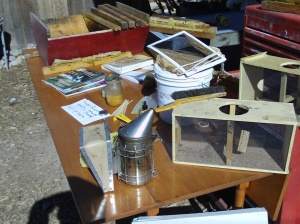
 When asked about hive collapse disorder, Casey sighted all the aspects of commercial beekeeping that weakens the hive: feeding on pesticide sprayed crops, spraying the hives to prevent mites, and over harvesting honey and replacing it with high fructose corn syrup. This improper care of hives, in his opinion, leads to hive collapse. The solution to lots of bees in the future? Lots of caring, small scale beekeepers. Join us July 19th for Casey’s second workshop here when the class will harvest the honey and make a salve from the bee wax.
When asked about hive collapse disorder, Casey sighted all the aspects of commercial beekeeping that weakens the hive: feeding on pesticide sprayed crops, spraying the hives to prevent mites, and over harvesting honey and replacing it with high fructose corn syrup. This improper care of hives, in his opinion, leads to hive collapse. The solution to lots of bees in the future? Lots of caring, small scale beekeepers. Join us July 19th for Casey’s second workshop here when the class will harvest the honey and make a salve from the bee wax.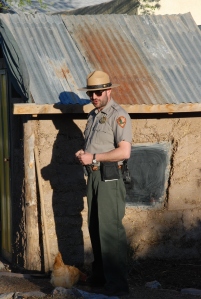 Probably the most entertaining event of our busy spring was the visit from Ranger Steve Reynolds, US Park Service. Jeremy Wilhelm, Minnisota screen writer, director, and actor arrived at our home in April looking so official in his uniform and dark sunglasses, I stumbled a little. Albuquerque local and location scouter extrodanare, Suzy Dillon, found the perfect location for college friend to demo his new comedy character – our gardens!
Probably the most entertaining event of our busy spring was the visit from Ranger Steve Reynolds, US Park Service. Jeremy Wilhelm, Minnisota screen writer, director, and actor arrived at our home in April looking so official in his uniform and dark sunglasses, I stumbled a little. Albuquerque local and location scouter extrodanare, Suzy Dillon, found the perfect location for college friend to demo his new comedy character – our gardens!  When I was a lonely farm girl in rural Illinois, I couldn’t wait to leave the country and live near friends. Now, a resident of central Albuquerque, I’ve lost the isolation of country life but still hold on to the slow pleasures of farm living. As our current social structure decays, backyard farming seems the clarifying answer to future thriving communities and my utopia of farm life but with friends. Urban farming: its farming, but cool.
When I was a lonely farm girl in rural Illinois, I couldn’t wait to leave the country and live near friends. Now, a resident of central Albuquerque, I’ve lost the isolation of country life but still hold on to the slow pleasures of farm living. As our current social structure decays, backyard farming seems the clarifying answer to future thriving communities and my utopia of farm life but with friends. Urban farming: its farming, but cool.  Melanie wants to put on a series of workshops that will transform her backyard publicly into a backyard farm. She is interested in fruit, vegetable, flower, and herb production, as well as chickens, bees, and even fish production! With Melanie’s admirable enthusiasm and my experience, we got to work developing and advertising for the series and collecting materials for the first workshop. The series would run through the summer and fall and begin with garden design.
Melanie wants to put on a series of workshops that will transform her backyard publicly into a backyard farm. She is interested in fruit, vegetable, flower, and herb production, as well as chickens, bees, and even fish production! With Melanie’s admirable enthusiasm and my experience, we got to work developing and advertising for the series and collecting materials for the first workshop. The series would run through the summer and fall and begin with garden design. 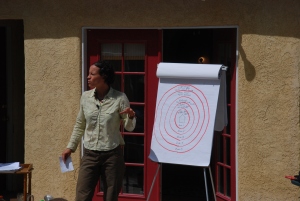
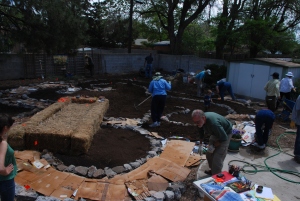

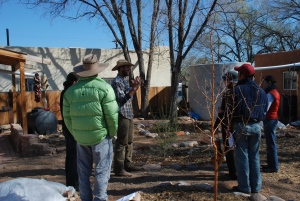


 First, we built a simple cold frame where we placed seed trays full of warm season seeds, like tomatoes and peppers. Bard built a three-sided wood frame topped with a recycled, glass showerdoor, laying at a 45 degree angle. We placed the cold frame against the south side of the house, using the adobe wall as the fourth side of the structure. In addition to the thermal mass of the wall, Bard lined the back wall with beer bottles full of water. Both these elements collect heat from the direct sunlight, then emit the heat at night when air temperatures fall. We sealed all the frames and they seam to retain nighttime warmth. During warm days, we crack the door so seedlings do not over-heat. We close the door every night and during windy afternoons.
First, we built a simple cold frame where we placed seed trays full of warm season seeds, like tomatoes and peppers. Bard built a three-sided wood frame topped with a recycled, glass showerdoor, laying at a 45 degree angle. We placed the cold frame against the south side of the house, using the adobe wall as the fourth side of the structure. In addition to the thermal mass of the wall, Bard lined the back wall with beer bottles full of water. Both these elements collect heat from the direct sunlight, then emit the heat at night when air temperatures fall. We sealed all the frames and they seam to retain nighttime warmth. During warm days, we crack the door so seedlings do not over-heat. We close the door every night and during windy afternoons. Secondly, we direct sowed cool weather veggies (lettuce, carrots, spinach, chard, onions, etc) in several growing beds and then covered them with row cover called reemay. We facened hoops out of salt-cedar branches to keep the reemay off the ground. Rocks and bricks hold the fabric down at its edges. We make sure soil of all seeds and seedlings stay evenly moist.
Secondly, we direct sowed cool weather veggies (lettuce, carrots, spinach, chard, onions, etc) in several growing beds and then covered them with row cover called reemay. We facened hoops out of salt-cedar branches to keep the reemay off the ground. Rocks and bricks hold the fabric down at its edges. We make sure soil of all seeds and seedlings stay evenly moist.



















